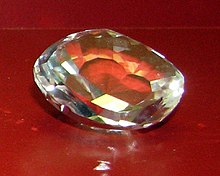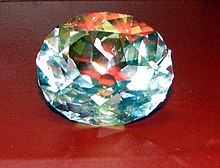Koh-i-Noor
The Koh-i-Noor (also spelled Koh-i-Nûr and Kooh-è Noor) is a large, colourless diamond that was found near Guntur in Andhra Pradesh, India, possibly in the 13th century.[1] The name means Mountain of Light in the Persian language.


Before it was cut for jewellery, it weighed 793 carats (158.6 g). It was first owned by the Kakatiya dynasty. Ownership of the stone changed several times between various ruling groups in South Asia over the next few hundred years. The Koh-i-Noor ended up in the possession of Queen Victoria after the British conquest of the Punjab in 1849. It is now part of the British Crown Jewels, part of the Royal Collection held in trust by Queen Elizabeth II for her successors and the UK.[2]
In 1852, Prince Albert, the husband of Queen Victoria, unhappy with its dull and irregular appearance, ordered it cut down from 186 carats (37.2 g). It emerged 42 per cent lighter as a dazzling oval-cut brilliant weighing 105.6 carats (21.12 g) and measuring 3.6 cm x 3.2 cm x 1.3 cm.[3]
Since arriving in the U.K., it has only ever been worn by female members of the family,[4] starting with Queen Victoria. After Queen Victoria's death, the Koh-i-Noor was set in the crown of Queen Alexandra, the wife of Edward VII. It was used to crown her at their coronation in 1902. The diamond was transferred to Queen Mary's crown in 1911,[5] and finally to the Queen Mother's crown in 1937.[6] When The Queen Mother died in 2002, it was placed on top of her coffin for her state funeral.[7]
Today, the diamond is set in the front of the crown, as part of the Crown Jewels of the United Kingdom. It is seen by millions of visitors to the Tower of London each year.
References
change- ↑ Kenneth J. Mears (1988). The Tower of London: 900 Years of English History. Phaidon. p. 100. ISBN 978-0-7148-2527-4.
- ↑ "FAQ: Does the Queen own the Royal Collection?". Royal Collection Trust. Retrieved 30 December 2015.
- ↑ Hubert Bari; Violaine Sautter (2001). Diamonds: In the Heart of the Earth, in the Heart of Stars, at the Heart of Power. Vilo International. p. 178. ISBN 978-2-84576-032-5.
- ↑ Kenneth J. Mears; Simon Thurley; Claire Murphy (1994). The Crown Jewels. Historic Royal Palaces Agency. p. 27. ASIN B000HHY1ZQ.
- ↑ Queen Mary's Crown. [1]
- ↑ Queen Elizabeth The Queen Mother's Crown. [2]
- ↑ "Priceless gem in Queen Mother's crown". BBC News. 4 April 2002. Retrieved 5 January 2016.